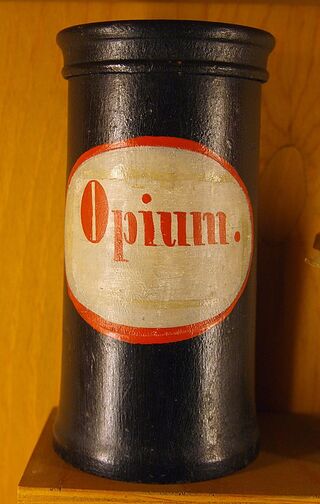Addiction
The Opium Eaters
Why are adolescents and young adults vulnerable to addiction?
Posted September 9, 2020

“An object of mingled horror and pity…with yellow pasty face, drooping lids and pin-point pupils…the wreck and ruin of a noble man,” he was a slave to this “burning poison,” writes Dr. Watson, of Sherlock Holmes fame, in Sir Arthur Conan Doyle’s The Man with the Twisted Lip (1891). Watson, sent to retrieve his patient from an opium den, credits the man’s addiction to his having read Thomas de Quincey’s Confessions of an English Opium-Eater (1886 edition, Project Gutenberg).

This account, though, hardly condones “the Circean spell of opium.” Though de Quincey (1785-1859) describes initial feelings of “cloudless serenity” when he, as a 19-year-old student, took a tincture of opium for an intractable toothache, he reveals that over time his full-blown opium addiction led to “suicidal despondency, anxiety and gloomy melancholy,” “chasms of sunless abysses,” and “moral and spiritual terrors” that drove him nearly to madness. He had such a “sense of incapacity and feebleness" that he could “not even attempt to rise.”
Opium is a natural substance derived from the poppy plant. It can be smoked, injected intravenously, or taken orally in pill form. Morphine and codeine are among the active ingredients in opium (Brownstein, Proceedings of the National Academy of Sciences, USA, 1993). There is evidence that opium was known in prehistoric times (Alam et al ACS Chemical Neuroscience, 2019). By the eighth century A.D., opium had been introduced to India and China. Alchemist Paracelsus (16th century) experimented with opium in alcohol that led to laudanum for medical use (Alam et al, 2019). Reports of drug abuse and tolerance surfaced by the 16th century (Brownstein, 1993).

Opium addiction was particularly severe among the Chinese by the mid-17th century once tobacco smoking was banned (Brownstein, 1993) and continued to increase over the late 18th and early 19th centuries as drug lords from Britain flooded the Chinese markets with opium they had procured from India in exchange for Chinese tea (Pomeranz, NY Review of Books, 6/6/19). By the mid-19th century, there are estimates that up to 12.5 million Chinese became addicted. In an attempt to stop this opium trade, the Chinese government imposed severe trade restrictions on the British. Britain, which received huge revenues from this illegal opium trade, fought the so-called Opium Wars (1839-1842 and 1856-1860) with China to maintain this lucrative commerce (Pomeranz, 2019). Ultimately, during this “Century of Humiliation,” China capitulated and allowed the legal trade of opium, leading to the eventual decline of the Qing Dynasty (Britannica.com).

Once a person is exposed to opiates repeatedly, he or she will develop tolerance (requiring a higher dose for the same effect), physical dependence that involves withdrawal symptoms (e.g. chills, insomnia, cramps, diarrhea, nausea, vomiting, dysphoria, anxiety, seizures) upon sudden discontinuation, and even hyperalgesia (increased pain), all affected by the opiate’s potency and route of administration (Volkow et al, Annual Review of Medicine, 2018). About half of those exposed to opiates have adverse effects, including dry mouth, nausea, sedation, dizziness, rashes, and constipation (Volkow et al, 2018).
Significantly, tolerance to the analgesic and rewarding effects develops sooner than tolerance to respiratory depression, and dose escalation to achieve the same effects can lead to overdose (Volkow et al, 2018). Clinicians can minimize overdose risk by prescribing the lowest effective daily dose, using short-acting formulations, and avoiding concomitant use of benzodiazepines (Chua et al, JAMA Pediatrics, 2020). The most serious adverse effect is, of course, the development of addiction. Over time, chemists have developed many semisynthetic and synthetic compounds derived from opium, including heroin and oxycodone, as well as antagonists (e.g. naloxone).

While tolerance and physical dependence are “common and expected consequences,” regardless of the type of opiates or patient variables, addiction is less common and develops over time (Volkow et al, 2018). Addiction is a chronic disorder that disrupts, i.e., hijacks, brain circuits involved in reward and motivation, executive control, and emotional processing and leads to the addicted person’s preference for immediate rewards at the expense of “prioritizing long-term benefits” (Volkow and Boyle, American Journal of Psychiatry, 2018). Though genetics accounts for about half of the risk for developing an addiction, a person's biological and psychological make-up interacts with environmental factors (Volkow and Boyle, 2018). Addiction is the term used specifically to describe compulsive preoccupation and drug-seeking behavior despite negative consequences.
It is difficult to predict who will develop an addiction after exposure to an initial opioid prescription. Adolescents who are prescribed an opiate, most commonly hydrocodone, for dental pain (e.g. wisdom teeth extraction) (Hudgins et al, Pediatrics, 2019; Schroeder et al, JAMA Internal Medicine, 2019) are vulnerable because their brains are still evolving and more “neuroplastic” than adult brains, with greater emotional reactivity, impulsivity, and less ability to self-regulate (Volkow and Boyle, 2018). This initial “safe” experience of pain relief may prime them for minimizing any perceived future risk (Miech et al, Pediatrics, 2015).

Risk factors include current or past substance use disorders, psychiatric co-morbidity (e.g. anxiety, depression), a family history of these disorders, and female gender (Volkow et al, 2018; Richardson et al, Journal of Adolescent Health, 2012; Harbaugh and Gadepalli, Current Opinion-Pediatrics, 2019). In one commercially insured sample of over 1 million adolescents first receiving opiates, 3 out of 1000 “transitioned” within three years to long-term opiate use, but those with preexisting mental health conditions were “substantially more likely” to continue long-term use (Quinn et al, JAMA Pediatrics 2018). Sometimes, those who are at higher risk are more apt to receive a prescription in what is called “adverse selection” (Quinn et al, Pain, 2019; Richardson et al, 2012).
Assessing how frequently misuse and addiction occur in this context of physician-prescribed medication for non-cancer patients is difficult. Studies vary considerably in their design (Quinn et al, 2019). For example, some fail to gather pertinent information on the dose, length, indication, effectiveness, age, or even family or psychiatric history (Miech et al, 2015). Many large-scale studies are based on questionnaires or retrospective chart review of insurance records on specific populations that may not have generalizability. Further, many studies use data of dispensed prescriptions, rather than those written or that reflect actual patient adherence. Of almost 15,000 patients, ages 16 to 25, who received opiates after dental procedures, there was a statistically significant increased risk for persistent opioid use (Schroeder et al, 2019). Those requesting refills of the original prescription and continuing use for a longer total duration were particularly susceptible to misusing opiates; the number of post-discharge prescriptions best predicted eventual misuse (Brat et al, BMJ, 2018).
Employing multiple, sophisticated designs to adjust for confounding, Quinn, of the School of Public Health, Indiana University, Bloomington, and his colleagues used a sample of over 1.5 million "opium-naive" Swedish adolescents and young adults (JAMA Pediatrics, 2020). They found that those receiving opiates had, within five years, only a 1 to 2% greater absolute risk of developing substance-related morbidity than those who received anti-inflammatory medication. Given the common practice of prescribing opiates for this age group, though, even this small absolute risk translates into substantial morbidity.

Bottom line: Opiate addiction remains a considerable public health problem in the U.S. Adolescents and young adults are particularly vulnerable because areas of their brain involved in impulse control and self-regulation are still developing. Many who eventually become addicted were given legitimate prescriptions for pain, often for dental procedures, just as 19th-century adolescent Thomas de Quincey. Those most at risk have a history of mental illness, previous substance abuse, or family history. It behooves clinicians who prescribe opiates to take a careful mental health history, avoid over-prescribing either dose or quantity, and remain cognizant of those who renew prescriptions.




